|
Venomous snakes are not only some of the most beautiful of snakes- they are also the most evolved in the
world. We have alot to learn from and about them. Some I've found to be placid in nature- others aggressive in behavior. All are
unpredictable and can be dangerous. If alot of us humans can learn to respect them and give them their space, there would
be alot less incidents with snakebite.
Generas:Agkistrodon, Crotalus, Sistrurus-
There are three different types of venomous snakes-
Solenglyphs- these snakes have long fangs on hinges that fold back in the roof of their mouths.There are apprx. 290 species
of this type, some of which are the fastest strikers in the world. When these snakes usually strike, they sit in a coiled
position, waiting for their prey. They then strike out unfolding their fangs into their victim.Like hypodermic needles, the
fangs inject a mixture of toxins, protiens,and enzymes.
there are two families of snakes in this catagory- Vipers (True Vipers) and Pit Vipers. The vipers cover the following
genera Crotalus-Sitrurus (rattlesnakes), Agkistrodons (copperheads and moccassins), Bitis (gaboon vipers and puff adders),
Bothrops (fer-de-lance), Tremeresurus (wagler's viper), and Atheris (bush vipers).
These snakes cover a wide range across the world. The vipers are someofthe most evolved of the venomous snakes. The family
of Pit Vipers include three genera- Crotoalus, Sistrurus, and agkistrodon. They have heat sensitive pits located between their
eye and nostrils which helpsthem to locate their warm blooded prey. they are truely living heat- seeking missels.
Let's take a look at the Rattlesnake (crotalus and sistrurus)-
Along with having a heat pit,they also have an audible warning system. These are a series of dry, interlocking segments
that makes a buzzing sound- otherwise known as the "rattle". A new segment is created each time the snake sheds it's skin,
which is usually 2-4 times a year.
The Proteroglyphs are a group that includes some of most venomous and deadliest in the world- the Elapids. They
have short fixed front fangs. There are as many as 250 species that are found in the tropics and some even in our oceans.
Several genera of this species include Micrurus (coral snake), Naja (cobras), Dendroaspis (mambas), and Bungarus (kraits).
The Colubrids include both venomous and non-venomous species. There are only two,however, that are highly venomous,
they are- Dispholidius (boomslang) and the Thelotornis (twig snake). Many colubrids are mildly venomous- they have fangs in
the rear of their mouths, located just beneth the eye. These include Boiga (mangrove and cat snakes), Heterodon (hognose
snake), and Chrysopetea (flying snake). And a majority have neither fangs nor venom. There are more than 2000 species
scattered throughout the world- 115 of which are in the U.S. alone.
Below are some stats on many of the snakes mentioned above that are indiginous to the southeast-
(Elapidae)
Eastern Coral Snake (Micrurus fulvius)-
Length- 22-471\2 inches
Venom Yield- normal-3-5mg
lethal- 4-5mg
Range- SE North Carolina to South Florida and Key Largo, west to South Texas and Mexico.
This sercretive serpent has a slender body with a head that has a blunted black nose. The color pattern is
red and black rings with black spots seperated by yellow thin rings. Always remember this rhyme- red on black, friend of Jack-
red on yellow, kill a fellow.
Their habitat consist of mesic,heavily vegetated hammocks near ponds or streams, in hardwood forests, sandhill areas,
and pine flatwoods with saw palmettos. This highly venomous snake has two mimics in our country- the Scarlet snake and the
scarlet kingsnake, which are non-venomous.
the Coral snake is usually seen or found under rotten logs or leaves or just moving about at dawn or dusk. During a raining
spell, they sometimes come out in broad daylight. They mainly feed on other smaller snakes and lizards, such as skinks.
|
|
(Crotalidae)
Eastern Diamondback Rattlesnake (Crotalus adamanteus)-
Length- 36-96 inches
Venom Yield- normal 492-600mg
lethal-100mg
Range- Lower coastal plains of North Carolina to Florida Keys, west to south Mississippi, and extreme east Louisiana.
Truely a glory to behold- this is the largest venomous snake in North America, and perhaps, the most dangerous as well.
It has a heavy body and a large diamond-shaped head. The back has a dark, diamond pattern outlined in a creamy whitesh border.
The eyes are covered by a dark wide band outlined with whitesh stripes.
This magnificent snake inhabits sandhills, longleaf pine, turkey oak woods, palmetto thickets, old farmlands, and some
islands with wiregrass in it's range. They occupy Gopher tortoise dens and stump holes during the warmer and cooler months
of the year. Their diet includes rats, rabbits, squirrels, and ground dwelling birds such as Quail.
Give this snake wide berth or it will defend itself aggresively if bothered. One bite from a large snake can easily
kill a man about four times over. Some are calm and some will strike with the slightest provocation.
This snake's population is on a rapid decline due to land developement and rattlesnake round-ups.
|
| Eastern Diamondback rattler |
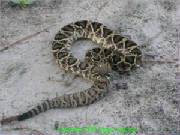
|
| This solitary serpent was 4 ft. long |
| Lucky Eastern Diamondback |
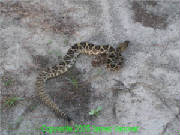
|
| This rattler was crossing a dirt road into someone's yard , lucky for it I came along. |
|
Canebrake and Timber Rattlesnake (Crotalus horridus)-
Length-35-741\2 inches
Venom Yield- normal 100-250mg
lethal-75-100mg
Range- Extreme SW Maine south to North Florida, west to SE Minnisota and Central Texas.
This is another large, and potentialy lethal rattlesnake. The northern forms' color ranges from yellow, brown, and
greyish to almost black with dark to black chevron like bands. The tails are black. The southern forms are called the Canebrake.
Their colors vary somewhat from their northern cousins. They are yellowish to pinkish-grey with a brick red stripe down the
center of their back. With their heads being light tan and a brown stripe running fromthe eyes tothe back of the upper jaw.
These beautiful pitvipers inhabit isolated hardwood, hillsides with rocky outcrops, lowland swamos, canebrake thicket,
and flood plains in the south. They are active in the spring all the way to the late fall months in the daytime. By summer,
they become more nocturnal,prfering to domost of their activity during the cooler hours of the day.
Their diet ranges from mice and squirrels, to chipmunks and birds. I have acctually seen one coiled at the foot of a
tree with a third of his body up on the tree waiting for a squirrel to come down. Most I have encountered arer placid and
calm- but take caution- these are one of the more dangerous rattlesnakes in our range.
The Canebrake in the more southern range have a high neurotoxic percentage of 37%. That is second only to the Mojave
rattlesnake in the western US.
|
| canebrake rattler |
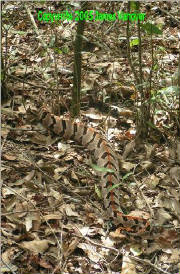
|
| this moster I called " Big Daddy " was 5 ft. long |
| Big Daddy the canebrake |
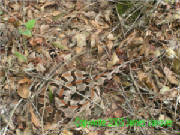
|
| got enough of me taking his picture |
|
Dusky Pigmy Rattlesnake (Sistrurus miliarius)-
Length- 15-30 inches
Venom Yield- normal-20-30mg/ Local to systematic effects.
Range-East North Carolina to Florida Keys, west to East Oklahoma and east Texas.
This greyish to redish little snake can be identified by the brown or black blotches found along the middle ofit's back.
It has uptothree spots in a row along it's side. Some have a broken-up brick redish stripe that runs a;longit's back. It also
has a redish brown to black bar that reaches from the eye to the rear of the jaw. The young are the same as the Copperhead
and Cottonmouths inthat they have yellow tails.
These little groundrattlers inhabit everglade prairies, pine palmetto flatwoods, mixed- up pine hardwood forest, cypress
swamp, and pond borders. Basically they can be located near any body of fresh water within their range. They can be found
sunning themselves across roads in the warmermonths.
They feed upon lizards, frogs, mice,young rats, insects, and have even been observed eating small snakes.
Because of their small rattles, they bob their heads as a visual warning. They sound more like an insect when rattling
than a snake. Although small in size, they pack a punch with their venom. It is a Hermoragic and very painful-
they have a "bite first, ask questions later" temperment, which makes them the chihuahuas of the rattlesnake world.
|
|
Cottonmouth or Water Moccasin (Agkistrodon piscivorus)-
Length-20-471/2 inches
Venom Yield- normal-100-150mg
lethal-100-150mg
Range- SE Virginia south to upper Florida Keys, west to south Illinois, southern Missiouri, south central Oklahoma, central
Texas. Isolated population in north central Missiouri.
A thick, dark colored and venomous watersnake. It's head is wide and thick set. The coloration of the cottonmouth ranges
from olive, brown, or black fromabove. They have a series of jagged dark crossbands- they kind of look like parenthesis (
) with a dark spot inside them. One of the best ways to identify the cottonmouth is that the side of it's head is pale
with a dark stripe that runs fromthe nose tothe back of the upper jaw. The young of these snakes have a bright yellow tail
which it uses to lure it's prey.
This pitviper inhabits lowland swamps, rivers, lakes, ponds, sloughs, ditches, slow moving creeks, and drying water holes.
Their diets consists of fish, frogs, birds, aquatic salamanders, and other snakes at times. They will also eat dead or
dying fish from water holes that are drying up. They seem to be a placid snake with a mild disposition. There has been
research to prove that they are the least likely to bite of all the venomous snakes in the US. I am not saying it is ok to
bother or pick one up. They will stand their ground with their body in a coil and mouth wide open if provoked. Their mouth
has a white interior- thus the name "cottonmouth". The bite of this snake is serious, though fatalities are rare. Their
venom has strong hemotoxic properties and is accompanied by massive necrosis which is sometimes followed by gangreen.
|
| Banded Water Snake headshot |
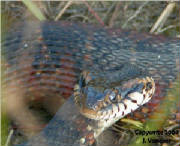
|
| Compare markings of this mimic to the Cottonmouth |
| Cottonmouth head shot |
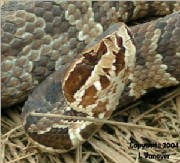
|
| Compare to the head of the non-venomous Banded Water Snake |
| cottonmouth |
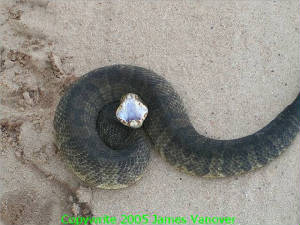
|
| typical cottonmouth defensive behavior |
|
|
| Southern copperhead |
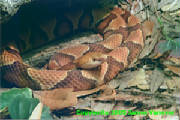
|
| This snake was captive when I took the shot. Later I will find a wild one for a better photo. |
Southern Copperhead (Agkistrodon contortrix)-
Length 22-53 inches
Venom Yield- normal-40-70mg
lethal-100mg
Range- SW Massachusetts, west to extreme SE Nebraska, south to Florida Panhandle, and south central and west Texas.
A heavily bodied pit viper, redish to brownish orange in color. It is distinct by the narrow neck leading to an
arrow shaped head. One of the best ways to identify this snake is that the markings resemble hour glasses. Newborns (or neonates),
have yellow tails to lure their prey with.
The Copperhead's habitat consists of wooded hillsides with rocky out croppings, above creeks or small bodies of water,
swamp edges in the coastal plains area. Copperheads like to bask during the day in the spring and fall, and become more nocturnal
during the warmer months. In the summer, they will retreat and hide out in piles of debris nearfarms, rotten logs, and rocks
near streams or creeks. Their diets consist of smallrodents,other reptiles, and even insects.
They are one of the least dangerous ofour venomous snakes, but don't let that fool you. Bites are very painful and are
usually accompanied by amputation of digits. The very young and elderly are also at higher risk of death if bitten.
|
|
|

